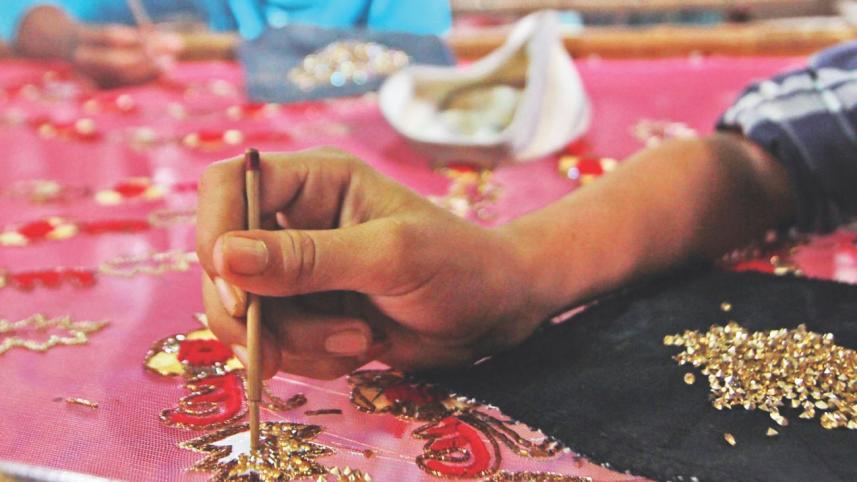Motif artisans in Ctg busy ahead of Eid

Motif artisans at the port city's Bihari Colony are busy trying to keep up with demand from boutiques and individuals ahead of Eid-ul-Fitr.
Workers, young and old, are seen hunched on the frames round-the-clock in an effort to deliver their creative handiwork in time, including beautiful Zardozi and Karchupi motifs on panjabis, saris and salwar suits.
Although the inhabitants of this colony, most of whom are Urdu speaking, have already left their traditional profession due to a slump in demand over the years, those who are still carrying the legacy hope for the return of golden days.
“It is our traditional profession and we have been doing motif work for many generations now,” said Mohammad Ali, a motif artisan who has been in the profession for around 20 years now, since the time he was 13 years of age.
There was a time when more than 100 motif artisans in the area were engaged in the profession, with the place abuzz round-the-year, he said.
The work flow was good in between 2000 and 2010, when he used to receive at least 15 orders -- ranging from salwar suits, saris and burqas -- on average every week.
But in the last couple of years, the demand for motif artisans' skills has been on the decline, with cheaper Indian merchandises flooding the market.
“The years 2014 and 2015 were the worst, as the number of orders dwindled to two to three a week.”
Subsequently, to make ends meet many of the motif artisans were compelled to find jobs in garment factories, Ali said, adding that about 50 of them have stuck around in this trade.
But the flow of orders has picked up this year: he now gets 10 orders on average a week. “We hope the numbers will go up and many will return to this line of work.”
Ali said their charges vary according to the intricacy and breadth of the designs.
For panjabis, it is Tk 500 to Tk 1,500, for salwar suits Tk 500 to Tk 3,000, and for burqas Tk 800 to Tk 2,000. For saris, the price starts at Tk 500 and goes up to Tk 25,000.
“I make a profit of around Tk 1,000 a day during this season and on other days, I make a profit Tk 500 a day, after bearing all the costs,” he added.
Md Raju, another motif artisan from the colony, which is situated in Ambagan area of Chittagong, agreed that the influx of Indian and Pakistani products is responsible for the downturn in their fortunes.
In the last two years, he received orders for just two salwar suits and two burqas on average a week.
But this year, the orders have increased to six or eight salwar suits and three to four burqas a week.
He hardly got orders for saris in the last two years, but this year, he is getting two to three sari orders a week ahead of Eid.
“Now that we have good orders, we do not have enough skilled people to do the works. So it becomes difficult to deliver products in time,” said Raju, adding that both boutiques and individuals are his buyers.
He charges Tk 1,000 to Tk 20,000 for motifs on salwar suits, Tk 3,500 to Tk 30,000 for saris and Tk 800 to Tk 1,200 for burqas.
Md Shafiq, another motif artisan, who has been in the profession for 18 years, said they have to invest in making the frames, buying materials and paying workers' wages.
“We work day and night to produce colourful dresses for the affluent members of the society. What keeps us going is that our work would bring a smile to those who would wear the outfits on the day of Eid.”




 For all latest news, follow The Daily Star's Google News channel.
For all latest news, follow The Daily Star's Google News channel.
Comments